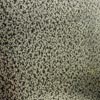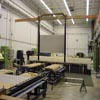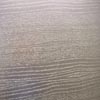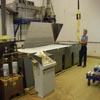A local supply service is offered on a plate
19 March 2010Hueck Engraving LLC was established in York, South Carolina, in September 1999. With this facility, Hueck Engraving, headquartered in Viersen, Germany, is able to offer press plates for the laminating industries in North America without the need for importing them. The York plant is located in the centre of the woodworking industries in the south east of the US.
To serve the worldwide high pressure laminate (HPL) market as well as the North American low pressure laminate (LPL) industry, Hueck’s machinery and technology is designed to produce double- sided as well as single-sided plates.
The company’s production technology consists of the following main processes: printing with etch resist by calender, which has the texture of the natural wood, for example; chemical etching with ferrous chloride to the requested depth of the texture; electro-polishing to match the perfect smoothness of a wood tick; sand blasting to the specified gloss; and chromium plating for high wear resistance and better release characteristics.
Working with the same concept as the mother company in Viersen, the ongoing visual comparison with a socalled master plate, as well as the use of topography measuring instruments and a gloss meter during all production steps ensures the quality of each plate produced, says Hueck LLC.
The York plant is capable of producing plates in the full range from 4ft x 8ft to 5ft x 12ft for the HPL market and from 4ft x 8ft up to 6ft x 18ft for the LPL market. Hueck says this gives it the capability to produce most of the plate sizes required for the flooring business. Plates for HPL production are produced according to the demands of the customer in a broad variety of designs, chromium plated as well as uncoated in stainless steel AISI 410 or AISI 630.
LPL plates or plates for short-cycle presses are delivered hard chromium plated to customer specification. For the flooring market it is of special interest that Hueck Engraving offers not only new plates but also refinishing and refurbishing in York.
As press cycle times of short-cycle presses are reduced more and more, and the number of pressings per day increases, the plates need to be serviced more often to maintain the high quality standard of the market. Hueck is calling these special services ‘Refinishing’ and ‘Refurbishing’.
Refinishing needs to be done if the plate does not have even gloss over the whole surface. The process involves removing the chromium layer, electro-polishing the texture, sand-blasting it to the right gloss level and chromium plating once more.
After this process the plate can be reintroduced into production like a new plate, the only difference being a slightly flatter texture. This can be done two to three times before a plate has to be refurbished.
Refurbishing needs to be done when the depth of the texture is not deep enough for refinishing. The process contains all the major steps involved in producing a new plate, but instead of using a new steel plate the steel from the old plate is used after the texture has been sanded off. This process can be carried out until the plate thickness is reduced to an amount where its stiffness is affected.
By offering this kind of service locally, says Hueck, its customers don’t need to send their plates out of the country to Europe any more. The number of plates per design that a customer needs can be reduced by the fact that the service cycle time is shorter, with obvious savings in time and money.
Together with the technical support from the mother company in Viersen, especially when it comes to new designs which have to be developed together with its customers, Hueck Engraving USA LLC claims it can be a strong partner for the laminating industry now and in the future.



